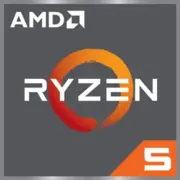AMD Ryzen 5 5600

AMD Ryzen 5 5600: Comprehensive Review of the 2025 Processor
Current Specifications, Assembly Tips, and Comparison with Competitors
Key Features: Zen 3, 7nm, and Performance Balance
The AMD Ryzen 5 5600, released in 2020, remains a popular choice for budget and mid-range PCs as of 2025. Here are its key specifications:
- Architecture: Zen 3 (Vermeer) — a revolutionary update that increased IPC (instructions per cycle) by 19% compared to Zen 2.
- Manufacturing Process: TSMC 7nm FinFET — an energy-efficient platform with a high transistor density.
- Cores/Threads: 6/12 — ideal for gaming and multitasking.
- Cache: 32 MB L3 — reduces latency in games and productivity applications.
- TDP: 65W — low power consumption even under load.
- Performance: Geekbench 6 — 2023 (single-core), 8527 (multi-core). For comparison, it was on top in 2020, but by 2025, it falls behind new Ryzen 7000/8000 processors while surpassing many budget models.
Key Features:
- Support for PCIe 4.0 (on B550/X570 chipsets) — relevant for fast NVMe drives.
- Precision Boost 2 technology — automatic overclocking up to 4.4 GHz.
- Low cost: by 2025, the processor is priced at $120–140, making it a good option for upgrading older AM4 systems.
Compatible Motherboards: AM4 Socket and Selection Nuances
The Ryzen 5 5600 uses the AM4 socket, which is considered outdated by 2025 (with AM5 taking its place). However, this is not a problem:
- Supported Chipsets:
- B550/X570: Best option. Support for PCIe 4.0, CPU and memory overclocking. Examples: MSI B550 Tomahawk ($130–150), ASUS TUF X570 ($160–180).
- A520/B450: Budget options, but may require a BIOS update to function properly. For example, Gigabyte B450 Aorus Elite ($80–90).
Tip: When buying a new motherboard in 2025, choose B550 — they are cheaper than X570 and retain PCIe 4.0 support. For upgrading an old system (e.g., with Ryzen 3000), you just need to update the BIOS.
Memory: DDR4 and Speed Optimization
The processor does not support DDR5, which is seen as a disadvantage in 2025 but saves budget:
- Recommended Specifications:
- Type: DDR4.
- Frequency: 3200–3600 MHz (optimal for Zen 3).
- Configuration: 2 modules (e.g., 16 GB = 2x8 GB) to activate dual-channel mode.
Example: Corsair Vengeance LPX 16 GB (3200 MHz) kit costs $45–55. Faster memory (3600 MHz) will provide a performance boost of 3–7% in games, but may not always justify the cost.
Power Supply: Power Calculation
With a TDP of 65W, the Ryzen 5 5600 is not demanding on power, but it’s important to consider the graphics card:
- Minimum Recommendation: 550W for systems with GPU level NVIDIA RTX 3060 or AMD RX 6600.
- For high-performance GPUs (RTX 4070/RX 7800 XT): 650–750W.
Recommended Models:
- Corsair CX550 (80+ Bronze, $60–70).
- Seasonic Focus GX-650 (80+ Gold, $90–100).
Important: Don’t skimp on the power supply. Cheap units with unstable voltage can damage components.
Pros and Cons of Ryzen 5 5600 in 2025
Pros:
- Price: $120–140 — twice as cheap as Ryzen 5 7600 ($250).
- Energy efficiency: ideal for compact builds.
- Gaming performance: 60+ FPS in Full HD (with GPU level RTX 3060).
Cons:
- No support for DDR5 and PCIe 5.0 — limits upgrade options.
- Outdated AM4 socket: a new build will require a platform change in the future.
Use Cases: Gaming, Work, Multimedia
1. Gaming: Paired with RTX 4060 or RX 7600, the processor will provide 100+ FPS in CS2, Fortnite, Cyberpunk 2077 (on medium settings).
2. Work Tasks:
- Video editing (Premiere Pro, DaVinci Resolve): rendering 1080p/1440p without issues.
- Programming/Multitasking: 12 threads handle Docker, IDE, and browser smoothly.
3. Multimedia: Streaming (OBS) + gaming — thanks to SMT (Simultaneous Multithreading).
Comparison with Competitors
- Intel Core i5-12400F ($130): Similar price, but Ryzen 5 5600 offers better performance in multi-threaded tasks (+15% in Cinebench R23).
- AMD Ryzen 5 7600 ($250): New Zen 4 architecture, DDR5 support, but twice as expensive. For gaming, the difference will be 10–15% FPS.
- Intel Core i5-13400 ($200): Wins in multi-threading (14 cores), but requires expensive LGA 1700 motherboards.
Conclusion: Ryzen 5 5600 is the best choice for a budget under $150. If DDR5 and future-proofing are priorities, consider investing in the Ryzen 5 7600.
Practical Assembly Tips
1. BIOS: For B450/B550 motherboards, a BIOS update may be required via USB Flashback (use the CPU-less method).
2. Cooling: The boxed Wraith Stealth cooler performs well, but for quieter operation, consider the DeepCool AK400 ($30).
3. RAM: Don’t buy DDR4 that's more expensive than 3600 MHz — Zen 3 rarely operates stably at high frequencies.
4. Storage: Choose NVMe PCIe 4.0 (e.g., Samsung 980 Pro) for maximum speed.
Final Conclusion: Who is the Ryzen 5 5600 Suitable For?
This processor is ideal for:
- Gamers on a Budget: Maximum FPS for $150.
- Owners of AM4 PCs: An upgrade from Ryzen 3/5 3000 without needing a motherboard replacement.
- Office and Multimedia Systems: Low power consumption and quiet operation.
Why is it still relevant in 2025? The price-to-performance ratio remains unmatched, and support for PCIe 4.0 and 32 MB cache prolong its lifespan. If you’re not chasing after DDR5 and high-end GPUs, it’s the best option under $200.
Basic
CPU Specifications
Memory Specifications
GPU Specifications
Miscellaneous
Benchmarks
Compared to Other CPU
Share in social media
Or Link To Us
<a href="https://cputronic.com/en/cpu/amd-ryzen-5-5600" target="_blank">AMD Ryzen 5 5600</a>


